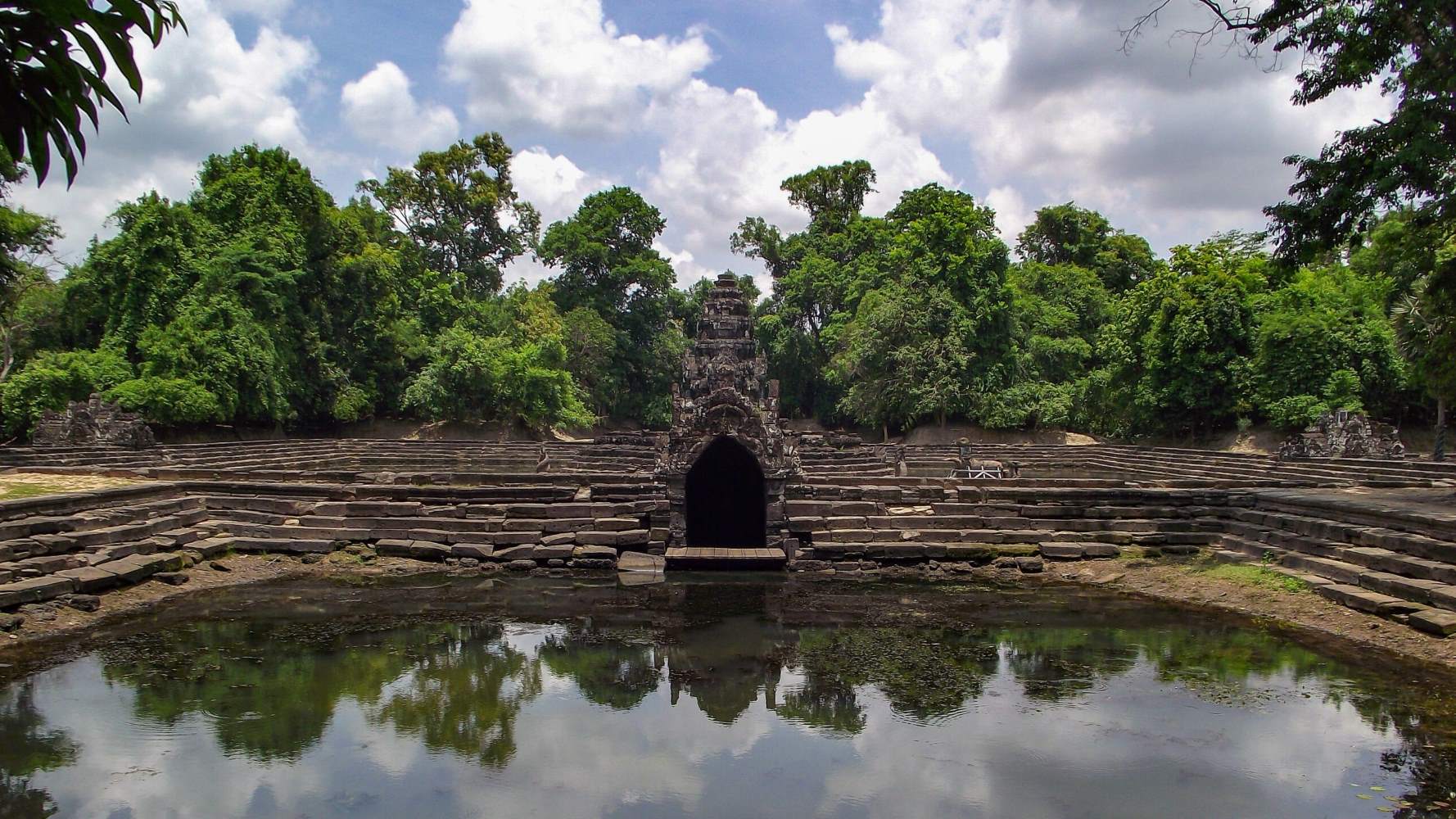
Neak Pean is a unique and fascinating temple located in the Angkor region of Cambodia. Built in the 12th century by King Jayavarman VII, this temple stands out due to its unusual design and purpose. Unlike other temples in the area, Neak Pean is situated on an artificial island in the middle of a large, square man-made pond. The temple's name means "entwined serpents," which refers to the two nagas (serpents) that encircle the central sanctuary. Neak Pean was originally constructed as a hospital, with the belief that the waters had healing properties. Visitors today can still marvel at the intricate carvings, serene atmosphere, and the innovative ancient engineering that made this temple a significant part of the Angkor complex.
What is Neak Pean?
Neak Pean is a small island temple located in the Angkor Archaeological Park in Cambodia. This unique site holds many fascinating aspects that make it a must-visit for history enthusiasts and travelers alike. Let's dive into some intriguing facts about Neak Pean.
Historical Significance of Neak Pean
Neak Pean is not just any temple; it has a rich history that dates back centuries. Here are some key historical facts:
- Built in the 12th Century: Neak Pean was constructed during the reign of King Jayavarman VII, one of the most famous Khmer kings.
- Part of Preah Khan: Originally, Neak Pean was part of the larger Preah Khan complex, which served as a Buddhist monastery and university.
- Symbolic Representation: The temple symbolizes the mythical Himalayan lake Anavatapta, believed to have healing properties.
- Dedicated to Avalokiteshvara: The central statue of Neak Pean is dedicated to Avalokiteshvara, the bodhisattva of compassion.
Architectural Marvels of Neak Pean
The architecture of Neak Pean is a testament to the ingenuity and creativity of the Khmer Empire. Here are some architectural highlights:
- Central Pond: The temple is built on an artificial island in the middle of a central pond, which is surrounded by four smaller ponds.
- Cruciform Layout: The layout of Neak Pean is cruciform, with the central pond representing the mythical lake and the four smaller ponds symbolizing the four great rivers of the earth.
- Stone Serpents: The name "Neak Pean" translates to "Entwined Serpents," referring to the stone serpents that encircle the temple.
- Lotus Motif: The central sanctuary is adorned with lotus motifs, symbolizing purity and enlightenment in Buddhism.
Unique Features of Neak Pean
Neak Pean stands out for its unique features that are not commonly found in other temples. Here are some of them:
- Healing Pools: The four smaller ponds were believed to have healing properties, with each pond representing a different element: water, earth, fire, and wind.
- Animal Spouts: Each of the four smaller ponds has a spout in the shape of an animal—elephant, horse, lion, and human—through which water flows into the central pond.
- Restoration Efforts: Neak Pean has undergone several restoration efforts to preserve its unique structure and historical significance.
- Accessible Only by Footbridge: Visitors can only reach Neak Pean by crossing a long wooden footbridge that spans the surrounding moat.
Cultural and Religious Importance
Neak Pean holds significant cultural and religious importance, both historically and in modern times. Here are some cultural insights:
- Buddhist Pilgrimage Site: Historically, Neak Pean was an important pilgrimage site for Buddhists seeking healing and spiritual purification.
- Symbol of Compassion: The temple's dedication to Avalokiteshvara highlights its role as a symbol of compassion and mercy.
- Influence on Khmer Art: The artistic elements of Neak Pean have influenced Khmer art and architecture for centuries.
- Modern-Day Worship: Even today, Neak Pean remains a place of worship and spiritual significance for many Cambodians.
Neak Pean in Popular Culture
Neak Pean has also made its mark in popular culture, drawing attention from around the world. Here are some interesting cultural references:
- Featured in Films: Neak Pean has been featured in several documentaries and films about Cambodia and the Angkor temples.
- Tourist Attraction: It is a popular tourist destination, attracting thousands of visitors each year who come to marvel at its unique beauty and historical significance.
- Inspiration for Artists: The temple has inspired numerous artists, photographers, and writers who have captured its essence in various forms of art.
- Educational Resource: Neak Pean serves as an educational resource for historians, archaeologists, and students studying the Khmer Empire and its architectural achievements.
The Magic of Neak Pean
Neak Pean isn't just another temple; it's a symbol of healing and spirituality. Built in the 12th century by King Jayavarman VII, this unique structure stands out with its central pond and four surrounding pools. Each pool represents one of the four elements: earth, water, fire, and wind. The central island with its horse statue adds to the temple's mystique.
Visiting Neak Pean offers a glimpse into ancient Khmer beliefs and their advanced engineering skills. The tranquil setting and historical significance make it a must-see for anyone exploring Angkor. Whether you're a history buff or just someone who loves beautiful places, Neak Pean won't disappoint. So next time you're in Cambodia, make sure to add this hidden gem to your itinerary. You'll leave with a deeper appreciation for the rich culture and history of the Khmer Empire.
Was this page helpful?
Our commitment to delivering trustworthy and engaging content is at the heart of what we do. Each fact on our site is contributed by real users like you, bringing a wealth of diverse insights and information. To ensure the highest standards of accuracy and reliability, our dedicated editors meticulously review each submission. This process guarantees that the facts we share are not only fascinating but also credible. Trust in our commitment to quality and authenticity as you explore and learn with us.


